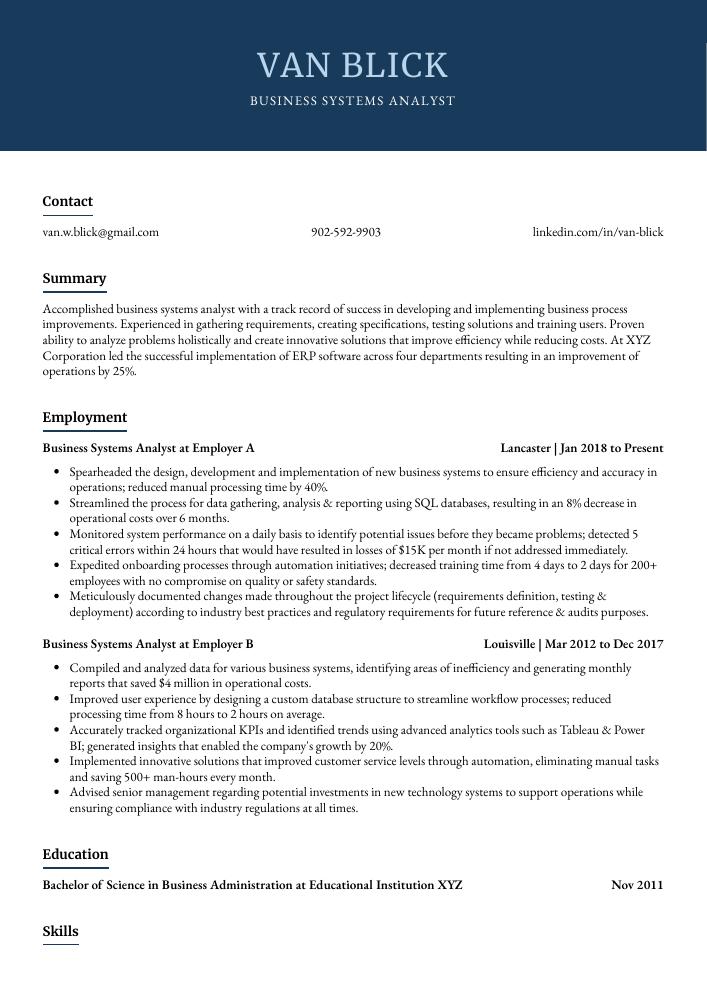Business Systems Analyst Resume Guide
Business systems analysts analyze the existing business systems of an organization, identify any problems or areas for improvement, and develop solutions to improve operational efficiency. They create detailed documentation for each system and ensure that all stakeholders understand the changes being made. Additionally, these professionals provide training on new processes as well as ongoing support.
You understand business systems like no one else, and can identify areas of improvement in any organization. To get employers to recognize your skill set, you must craft a resume that stands out from the rest.
This guide will walk you through the entire process of creating a top-notch resume. We first show you a complete example and then break down what each resume section should look like.
Table of Contents
The guide is divided into sections for your convenience. You can read it from beginning to end or use the table of contents below to jump to a specific part.
Business Systems Analyst Resume Sample
Sydney Cormier
Business Systems Analyst
[email protected]
840-612-0245
linkedin.com/in/sydney-cormier
Summary
Accomplished business systems analyst with a track record of success in developing and implementing business process improvements. Experienced in gathering requirements, creating specifications, testing solutions and training users. Proven ability to analyze problems holistically and create innovative solutions that improve efficiency while reducing costs. At XYZ Corporation led the successful implementation of ERP software across four departments resulting in an improvement of operations by 25%.
Experience
Business Systems Analyst, Employer A
Hollywood, Jan 2018 – Present
- Spearheaded the design, development and implementation of new business systems to ensure efficiency and accuracy in operations; reduced manual processing time by 40%.
- Streamlined the process for data gathering, analysis & reporting using SQL databases, resulting in an 8% decrease in operational costs over 6 months.
- Monitored system performance on a daily basis to identify potential issues before they became problems; detected 5 critical errors within 24 hours that would have resulted in losses of $15K per month if not addressed immediately.
- Expedited onboarding processes through automation initiatives; decreased training time from 4 days to 2 days for 200+ employees with no compromise on quality or safety standards.
- Meticulously documented changes made throughout the project lifecycle (requirements definition, testing & deployment) according to industry best practices and regulatory requirements for future reference & audits purposes.
Business Systems Analyst, Employer B
Salinas, Mar 2012 – Dec 2017
- Compiled and analyzed data for various business systems, identifying areas of inefficiency and generating monthly reports that saved $4 million in operational costs.
- Improved user experience by designing a custom database structure to streamline workflow processes; reduced processing time from 8 hours to 2 hours on average.
- Accurately tracked organizational KPIs and identified trends using advanced analytics tools such as Tableau & Power BI; generated insights that enabled the company’s growth by 20%.
- Implemented innovative solutions that improved customer service levels through automation, eliminating manual tasks and saving 500+ man-hours every month.
- Advised senior management regarding potential investments in new technology systems to support operations while ensuring compliance with industry regulations at all times.
Skills
- Business Analysis
- Process Improvement
- Requirements Analysis
- SQL
- Visio
- SDLC
- Business Process Improvement
- Data Analysis
- Requirements Gathering
Education
Bachelor of Science in Business Administration
Educational Institution XYZ
Nov 2011
Certifications
Certified Business Analysis Professional (CBAP)
International Institute of Business
May 2017
1. Summary / Objective
Your resume summary should be a concise overview of your experience and qualifications as a business systems analyst. Include details such as the programming languages you are familiar with, any certifications or awards you have received, and how many years of experience in this field you possess. You can also mention specific projects that demonstrate your problem-solving skills and ability to analyze complex data sets.
Below are some resume summary examples:
Detail-oriented business systems analyst with 5+ years of experience in analyzing and optimizing business operations. Proven track record of delivering innovative solutions that improve efficiency, reduce costs, and increase customer satisfaction. Skilled at developing user requirements to effectively design new systems or modify existing ones for improved performance. Possess strong communication skills and the ability to work collaboratively within cross-functional teams.
Driven Business Systems Analyst with 5+ years of experience in project management and business process design. Proven track record of streamlining operations, reducing costs, and boosting efficiency through strategic analysis of existing systems. Expertise in creating comprehensive requirements documents to ensure accurate development execution. Focused on delivering high-quality results while significantly increasing user satisfaction ratings.
Hard-working business systems analyst with 5+ years of experience in analyzing, designing and implementing software solutions. Proven record of success in increasing efficiency by streamlining processes for a variety of businesses from small startups to Fortune 500 companies. Skilled at gathering requirements, writing user stories and creating system flow diagrams that ensure accuracy and quality assurance throughout the entire process.
Well-rounded business systems analyst with 7+ years of experience in optimizing and streamlining processes. Proven track record of successfully leading projects to completion, including a 40% reduction in cost via automation at XYZ Corporation. Seeking to join ABC Corp as the next Business Systems Analyst where I can make use of my strong analytical skills and deep knowledge of business operations to drive growth and development.
Proficient business systems analyst with 7+ years of experience in gathering and analyzing business requirements, creating technical designs, developing solutions, and troubleshooting issues. Seeking to join ABC Corp as a Business Systems Analyst to leverage my expertise in optimizing processes for increased efficiency while reducing costs. At XYZ Inc., saved $1M by streamlining the sales process using automated workflows.
Seasoned business systems analyst with 8+ years of experience in developing, implementing and managing business solutions. Skilled in gathering requirements, analyzing data and identifying process optimizations to deliver value-based solutions that meet customer needs. At XYZ Corporation increased user satisfaction by 24% through improved system performance monitoring and analysis.
Dependable Business Systems Analyst with 5+ years of experience developing and executing software applications. Skilled in gathering business requirements, leading data analysis projects, testing systems for accuracy, and providing support to end users. Seeking to leverage my expertise at ABC Company to provide efficient solutions that improve the customer experience.
Passionate business systems analyst with 4+ years of experience in process optimization, data analysis and project management. Seeking to utilize strong problem-solving and analytical skills at ABC Corporation to help drive growth through improved business processes. At XYZ Inc., identified areas for improvement resulting in a 20% decrease in order processing time.
2. Experience / Employment
In the experience/employment/work history section, you should list your positions in reverse chronological order. This means that the most recent job is listed first.
When writing out what you did for each position, stick to bullet points primarily. Doing so allows the reader to quickly digest and understand what it was that you accomplished during your roles. When writing these bullets, make sure to provide detail about what exactly it was that you did and any quantifiable results obtained from those actions.
For example, instead of saying “Developed business solutions,” say “Designed a new system architecture which resulted in an average 10% improvement across all departments.”
To write effective bullet points, begin with a strong verb or adverb. Industry specific verbs to use are:
- Analyzed
- Designed
- Implemented
- Documented
- Developed
- Tested
- Troubleshot
- Monitored
- Evaluated
- Streamlined
- Automated
- Resolved
- Optimized
- Configured
- Upgraded
Other general verbs you can use are:
- Achieved
- Advised
- Assessed
- Compiled
- Coordinated
- Demonstrated
- Expedited
- Facilitated
- Formulated
- Improved
- Introduced
- Mentored
- Participated
- Prepared
- Presented
- Reduced
- Reorganized
- Represented
- Revised
- Spearheaded
- Structured
- Utilized
Below are some example bullet points:
- Introduced new software systems and process improvements, which successfully streamlined operations for 3 departments; this reduced overhead costs by 10%.
- Troubleshot system malfunctions and operational issues encountered during the implementation of new business applications, resulting in improved user satisfaction ratings of 87%.
- Thoroughly analyzed customer requirements to customize existing software solutions that met their needs; updated 50+ databases within a 3-month period with 100% accuracy.
- Documented technical specifications such as data flows & interfaces, coding standards, security policies etc., ensuring compliance with established procedures across all projects undertaken.
- Represented the IT department at various internal meetings to discuss progress on systems development initiatives; provided critical insights into project timelines & cost estimates which resulted in successful completion of 6 large-scale implementations within budget constraints.
- Structured complex business systems and processes to streamline operations, resulting in a 15% decrease in operational costs.
- Utilized SQL scripting language to develop database automation solutions that improved data accuracy by 20%.
- Effectively identified key areas of improvement within the organization’s existing IT infrastructure, then proposed cost-efficient solutions for implementation and execution.
- Mentored junior team members on system analysis techniques; successfully trained 3 new analysts with an overall pass rate of 93%.
- Configured multiple web applications for clients according to their specific requirements, ensuring compliance with industry standards and regulations at all times.
- Upgraded existing business systems and processes, leading to a 10% increase in operational efficiency.
- Reduced costs by 20%, through the streamlining of redundant data management tasks and consolidation of existing databases.
- Independently designed and implemented an automated workflow system which improved customer satisfaction ratings by 25%.
- Optimized employee productivity with advanced reporting tools, resulting in a 15% reduction in time required for administrative tasks across all departments.
- Tested multiple software solutions against functional requirements before selecting the most suitable option; successfully completed 3 projects within budget ahead of schedule within 6 months on average per project cycle.
- Developed and maintained IT systems, databases and business applications to improve efficiency of operations; achieved 60% reduction in system downtime.
- Revised existing processes and procedures to enhance workflow productivity by over $10,000 annually while ensuring data accuracy throughout the company.
- Achieved significant cost savings for clients through detailed analysis of current systems & implementation of new technologies that eliminated unnecessary overhead expenses.
- Automated routine tasks such as report generation and customer service inquiries, resulting in 200+ hours saved each quarter for the organization’s IT team members.
- Competently evaluated software development life cycle (SDLC) stages from requirements gathering through design, testing/implementation and maintenance on projects with budgets up to $1 million+.
- Demonstrated expertise in business analysis, requirement gathering and system documentation by successfully completing over 20 projects with varying complexities within deadlines.
- Prepared detailed technical reports to identify process improvements that reduced manual efforts by 45%, resulting in cost savings of $30K annually for the organization.
- Participated actively in user acceptance testing (UAT) phases to ensure accuracy of functionalities developed; achieved zero errors/bugs post implementation on all projects handled.
- Substantially improved operational efficiency via automation using various scripting languages such as Python and Bash Shell; increased time-to-market rate from 8 weeks to 3 weeks across multiple systems deployments.
- Formulated comprehensive test plans based on project requirements, executed them accurately and provided regular status updates ensuring seamless transition into production environment with no downtime or data loss incidents occurring along the way.
- Efficiently analyzed and designed business systems for 4+ clients, integrating various software platforms and increasing organization-wide efficiency by 35%.
- Resolved over 200 user support tickets during the course of 1 year; decreased average response time from 3 days to less than 24 hours.
- Presented detailed reports on system performance speed & accuracy tests to senior management team, resulting in an additional $5 million investment into IT infrastructure upgrades.
- Evaluated existing processes across a variety of sectors including finance, healthcare & retail; identified opportunities for improvement and generated cost savings of up to $50K annually per client.
- Designed customized workflow solutions using SQL databases and JavaScript programming language; reduced manual labor associated with data entry tasks by 45%.
- Assessed current business systems for efficiency and effectiveness, identifying areas of improvement to increase productivity by 20% and reduce costs by $8,000.
- Reorganized existing data systems to ensure accuracy and consistency across departments, streamlining processes that saved over 160 hours annually in manual work.
- Facilitated integration efforts between internal IT teams and external vendors while providing technical support throughout the process; successfully implemented 8 new software solutions within a six-month period.
- Coordinated with stakeholders to identify gaps in current system capabilities, then developed innovative solutions that surpassed customer expectations without compromising quality or reliability standards.
- Successfully deployed beta testing programs on multiple projects simultaneously before their final release into production environments; achieved zero defects upon launch every time!
3. Skills
Skill requirements will differ from one employer to the next; this can easily be ascertained from the job posting. Organization A may be looking for someone with experience in Microsoft Dynamics and Organization B may be looking for expertise in Salesforce.
To ensure that your resume is seen by a human, you want to tailor the skills section of your resume to each job you are applying for. This is because many employers use applicant tracking systems these days which scan resumes for certain keywords before passing them on to a human.
You should also elaborate on the most important ones in other sections such as summary or experience; this will help demonstrate why you are an ideal candidate and how you can add value if hired.
Below is a list of common skills & terms:
- Access
- Agile Methodologies
- Analysis
- Business Analysis
- Business Intelligence
- Business Process
- Business Process Improvement
- Business Requirements
- CRM
- Change Management
- Cross Functional Team Leadership
- Data Analysis
- Data Warehousing
- Databases
- ERP
- Financial Analysis
- HTML
- Integration
- Java
- JavaScript
- Microsoft SQL Server
- Oracle
- Problem Solving
- Process Improvement
- Program Management
- Project Planning
- Quality Assurance
- Requirements Analysis
- Requirements Gathering
- Risk Management
- SAP
- SDLC
- SQL
- SharePoint
- Software Development
- Software Development Life Cycle
- Software Documentation
- Software Project Management
- Systems Analysis
- Team Leadership
- Teamwork
- Technical Support
- Testing
- Time Management
- Troubleshooting
- User Acceptance Testing
- Vendor Management
- Visio
- Windows
4. Education
Including an education section on your resume will depend on how much experience you have. If you just graduated and have no prior work history, mention your education below your resume objective. On the other hand, if you are an experienced business systems analyst with lots of projects to showcase, omitting the education section is perfectly fine.
If including an education section in your resume is appropriate for this role, try to include courses and subjects related to the business systems analyst job description that demonstrate a strong understanding of relevant skills and concepts.
Bachelor of Science in Business Administration
Educational Institution XYZ
Nov 2011
5. Certifications
Certifications are a great way to demonstrate your knowledge and expertise in a particular field. They can also be used to show potential employers that you have taken the time and effort to stay up-to-date with industry trends.
Including certifications on your resume is an effective way of showing hiring managers that you are qualified for the job, so make sure they are prominently featured if applicable.
Certified Business Analysis Professional (CBAP)
International Institute of Business
May 2017
6. Contact Info
Your name should be the first thing a reader sees when viewing your resume, so ensure its positioning is prominent. Your phone number should be written in the most commonly used format in your country/city/state, and your email address should be professional.
You can also choose to include a link to your LinkedIn profile, personal website, or other online platforms relevant to your industry.
Finally, name your resume file appropriately to help hiring managers; for Sydney Cormier, this would be Sydney-Cormier-resume.pdf or Sydney-Cormier-resume.docx.
7. Cover Letter
Including a cover letter with your job application is a great way to make sure you are noticed by recruiters and hiring managers. This document typically consists of 2-4 paragraphs, which provide more detail about yourself and why you would be an excellent fit for the role.
Not all jobs require a cover letter but writing one can give you an edge over other applicants. It allows you to express your personality in addition to providing additional information that may not have been included in your resume.
Below is an example cover letter:
Dear Hunter,
I am writing in response to your posting for a Business Systems Analyst. With experience in business analysis and project management, as well as a strong technical background, I am confident I can be an asset to your organization.
In my current role, I work with clients to understand their business needs and requirements, and then translate those into system specifications. I have experience with a variety of software applications and tools, including Salesforce, Jira, Confluence, and MS Office. I am also familiar with Agile methodology and have experience working in Scrum environments.
Through my work experiences, I have developed strong analytical and problem-solving skills that would benefit your organization. In addition, I am able to effectively communicate with both technical and non-technical staff. My ability to bridge the gap between these two groups makes me an ideal candidate for this position.
I’ve attached my resume for your review. Please feel free to contact me if you have any questions or would like to discuss my qualifications further. Thank you for your time and consideration; I look forward to hearing from you soon!
Sincerely,
Sydney
Business Systems Analyst Resume Templates
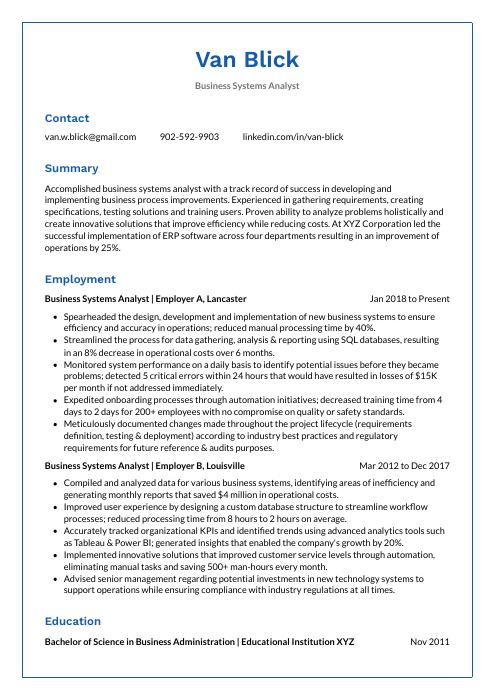 Markhor
Markhor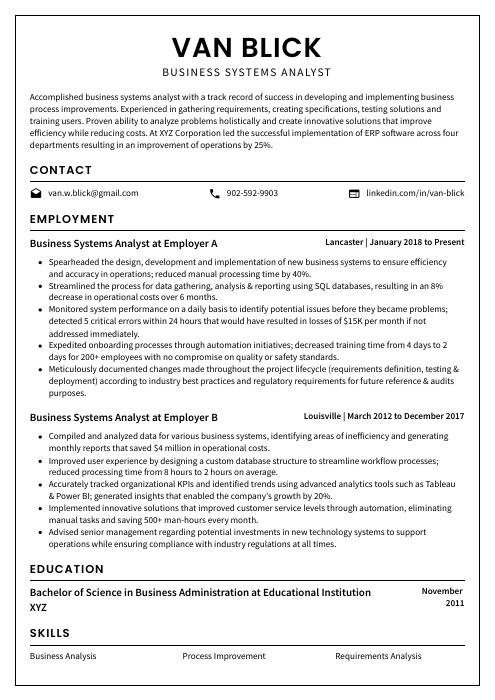 Cormorant
Cormorant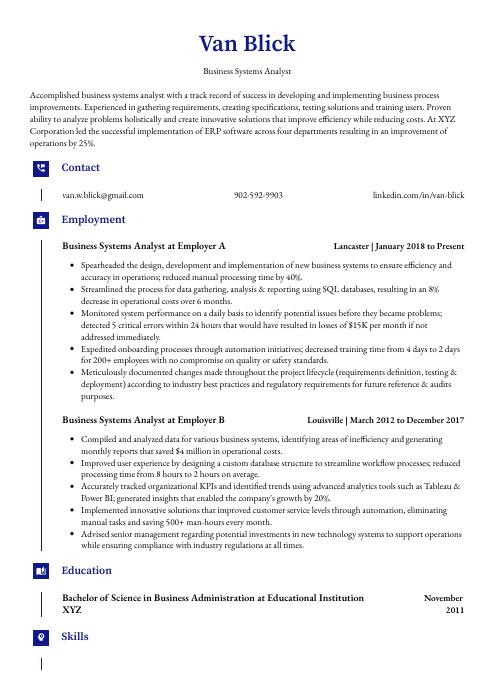 Gharial
Gharial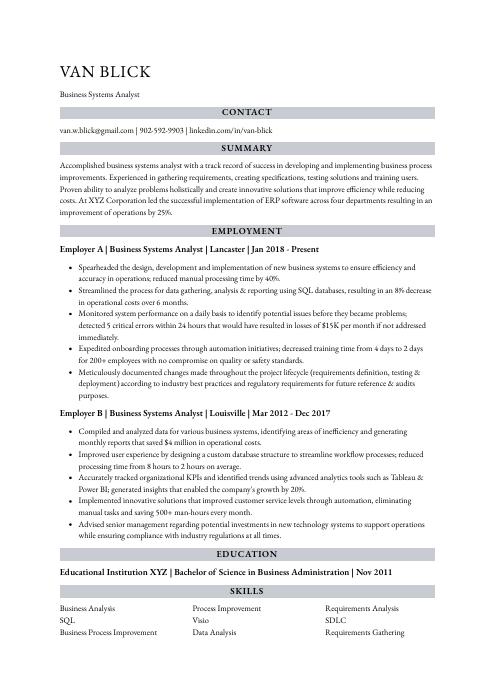 Numbat
Numbat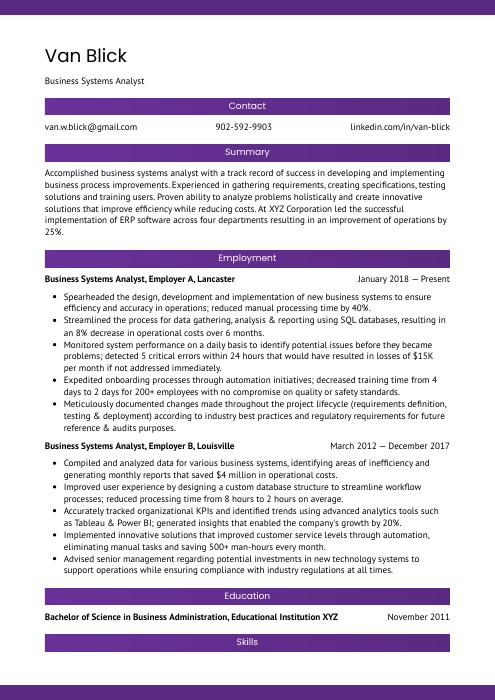 Jerboa
Jerboa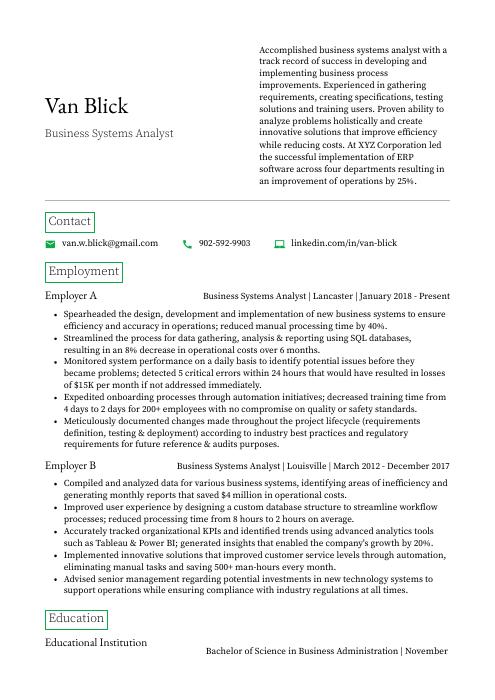 Quokka
Quokka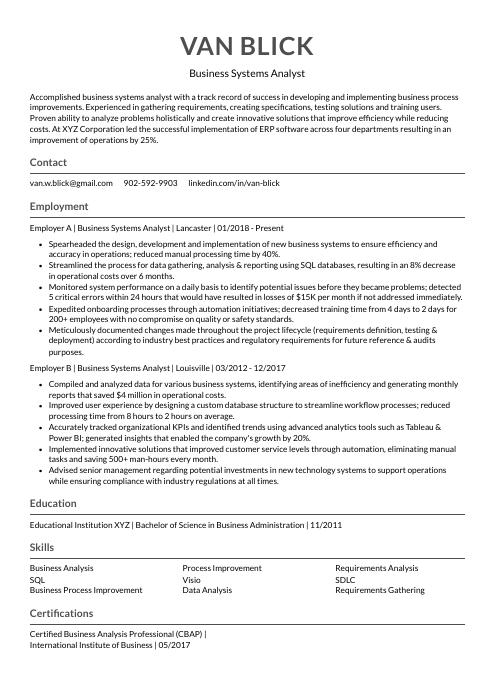 Indri
Indri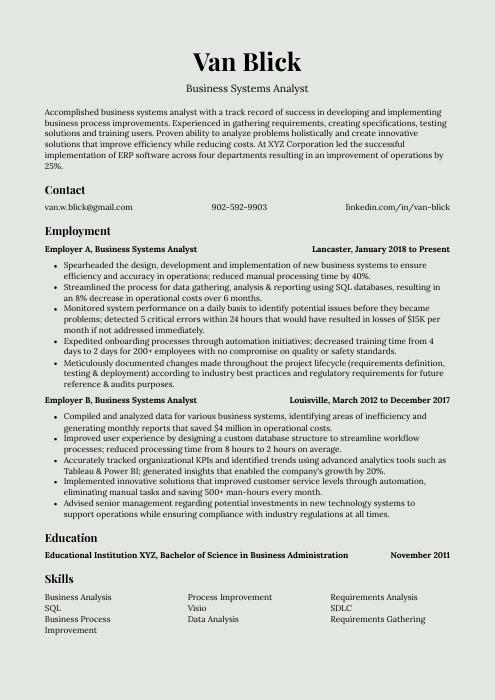 Saola
Saola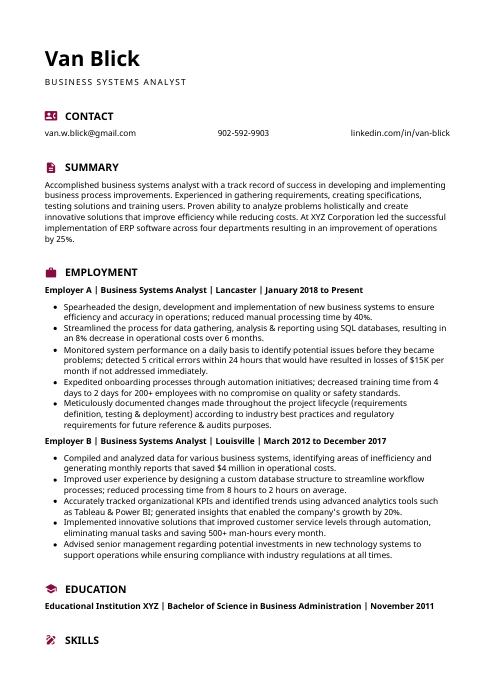 Hoopoe
Hoopoe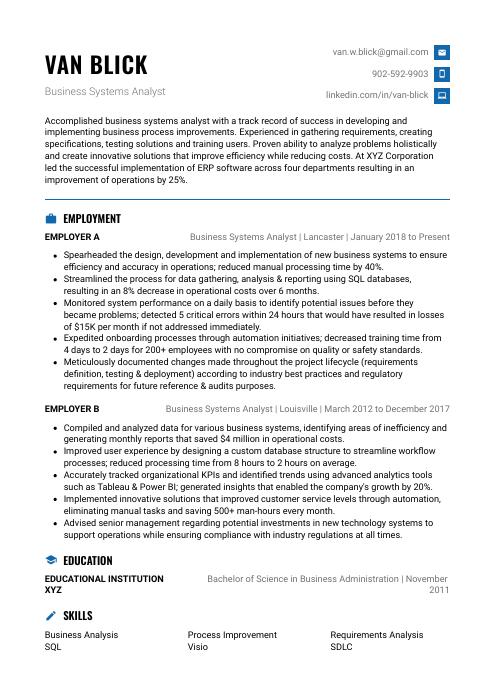 Echidna
Echidna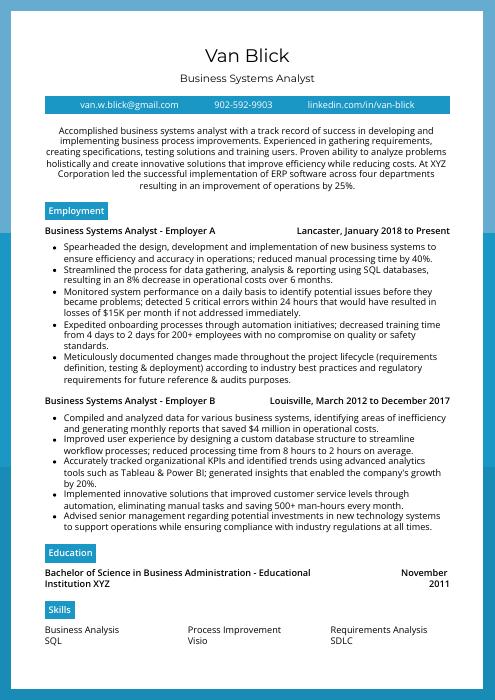 Rhea
Rhea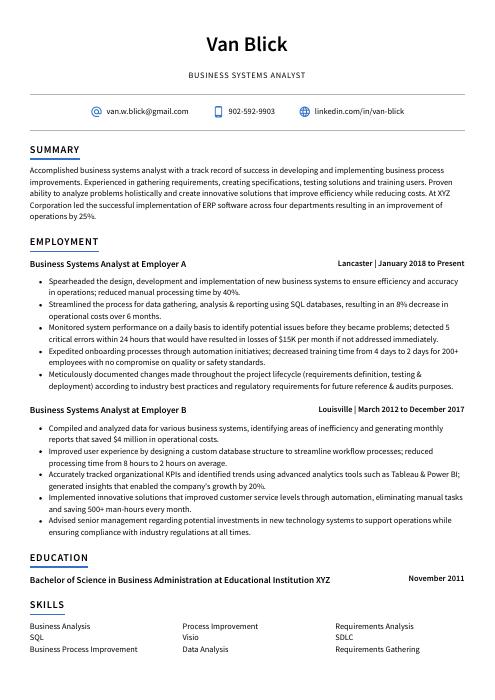 Axolotl
Axolotl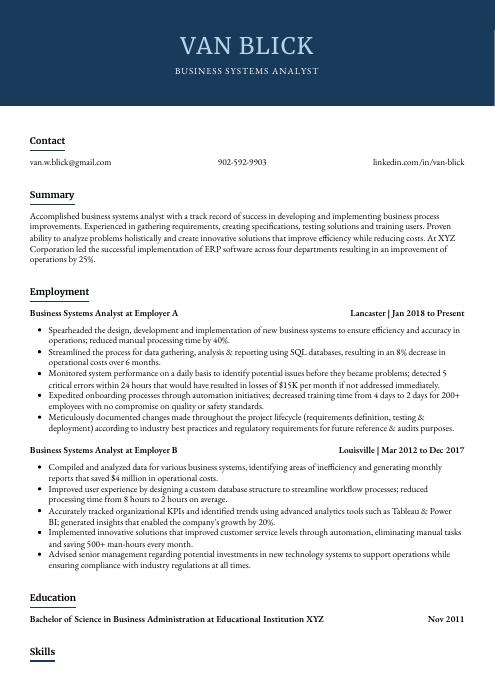 Bonobo
Bonobo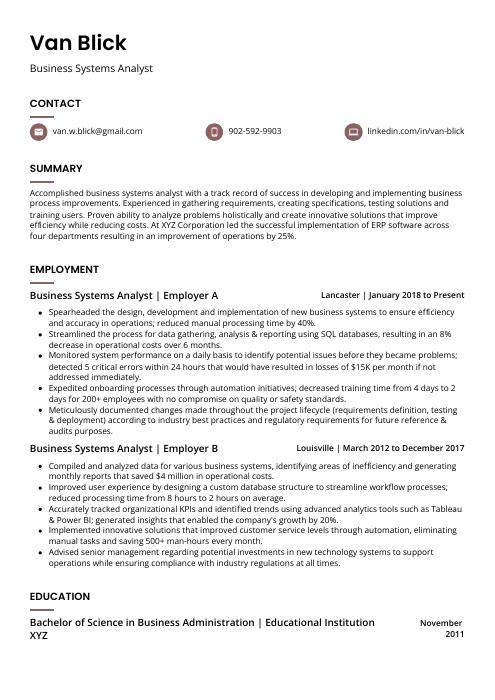 Fossa
Fossa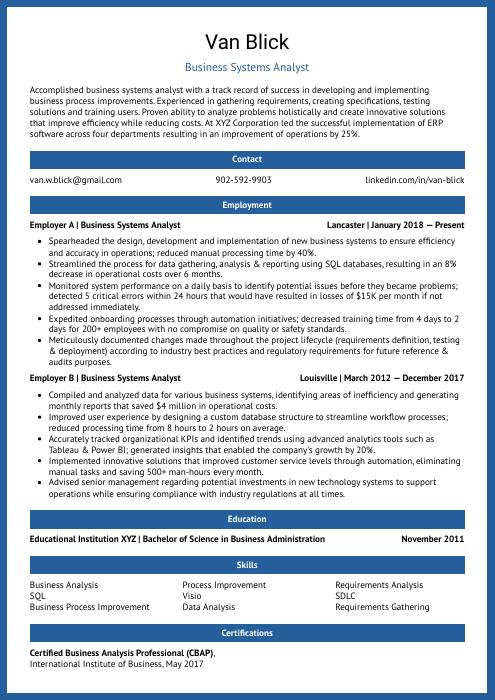 Ocelot
Ocelot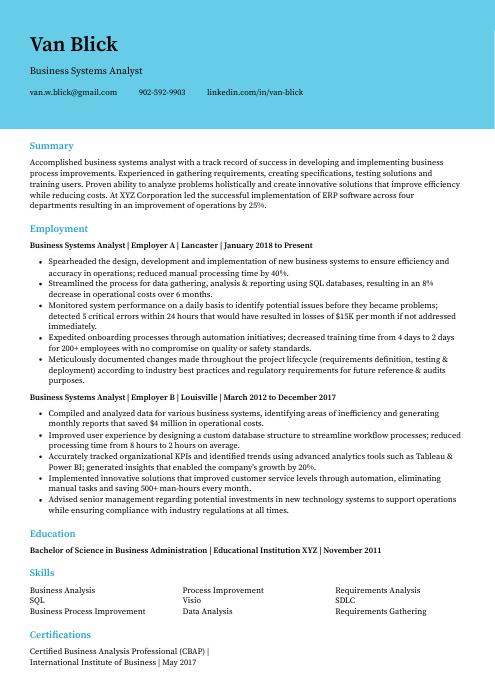 Dugong
Dugong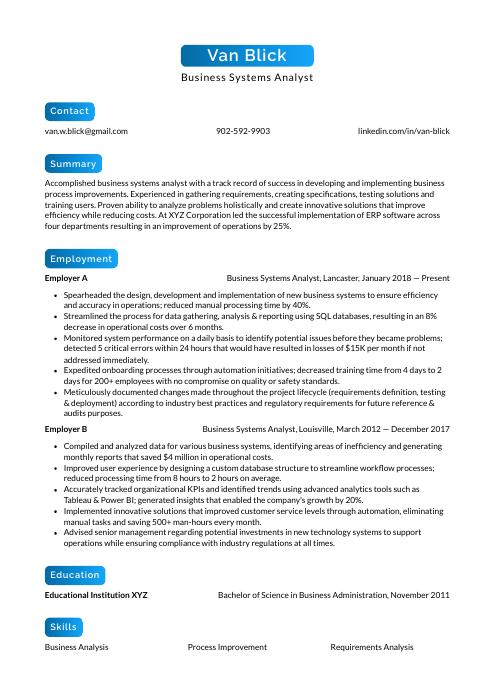 Kinkajou
Kinkajou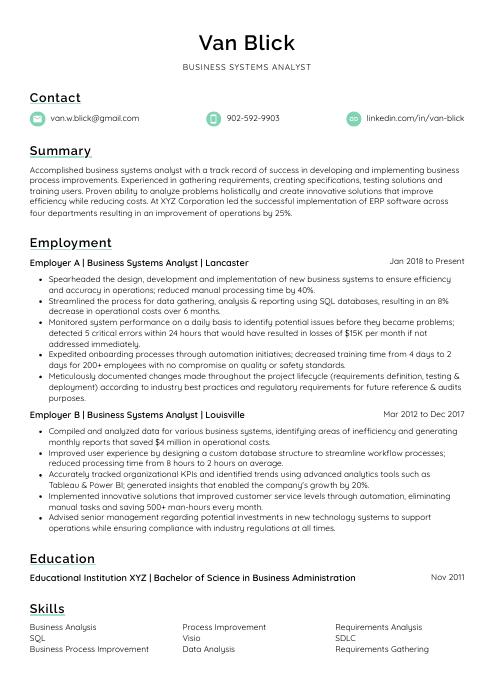 Lorikeet
Lorikeet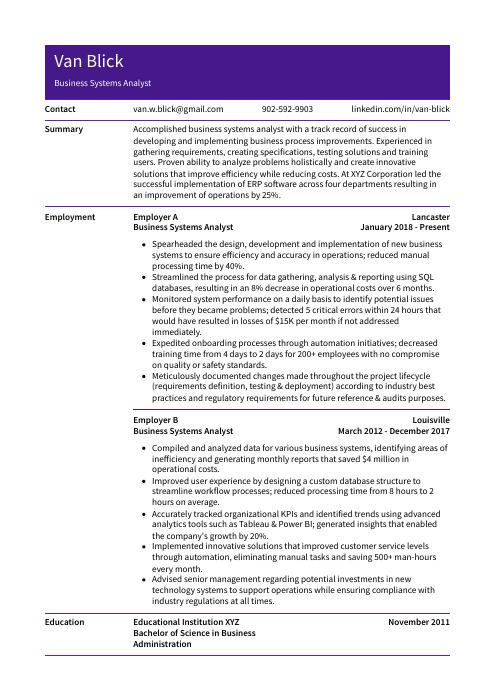 Pika
Pika Rezjumei
Rezjumei
